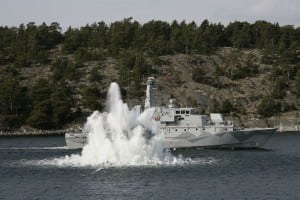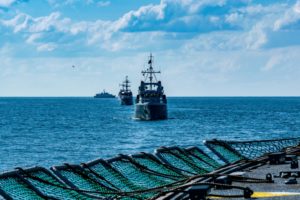The chief of the Royal Swedish Navy said the threat of gray zone activity in Northern Europe waters shows the importance of presence at sea and information sharing within and among partner nations.
In both the busy Baltic Sea and Sweden’s west coast the issue with trading routes is “it’s very easy to hamper or harass” without anyone seeing or knowing about it. That highlights the importance of Sweden’s Navy being present, both because it can have eyes on activity but “we can also both show our flag of course to other nations, but also to show that we are ready to protect the merchant shipping, if that is the one that is being harassed,” Rear Adm. Ewa Skoog Haslum said during a Tuesday online event with the American Enterprise Institute.

The discussion focused on the threat of increasing Russian grey-zone activities in the region that do not rise to the level of military response.
“But the sea lines of communication that is very much an international and national concern to have those safe routes,” she continued.
When asked how Sweden can defend its long coastline, Haslun noted they need to think of it as a total defense task.
“In Sweden we are now rebuilding the total defense. We are looking at the civilian authorities together with the military armed forces and we are together building a new kind of defense that really includes the whole society. Because all the agencies we have…we need to work together.”
Haslun highlighted the importance of sharing accurate information, both nationally and internationally. She said it is powerful to own trustworthy information, but they must keep digital information safe from being manipulated, blocked, or intercepted.
Haslun said Sweden along with its neighbors are dependent on exercising together to sustain security in the seas. Sweden is not a member of NATO but often participates in exercises as a partner.
“We are dependent on exercising together to be strong when it’s needed, because we can’t believe that we can be strong and robust when it’s needed if we haven’t exercised before….we try to exercise as much as we can together,” including with the United States when the Navy enters the Baltic Sea region.
Haslun said Sweden is now focusing on “day-zero connectivity” with its partners, including in procurement decisions, so Swedish forces can easily work with NATO forces in exercises without communications issues.
At the same event, Vice Adm. Andrew Lewis, Commander of U.S. 2nd Fleet, agreed on the importance of exercises and noted how much he and the Navy can learn from its European and Swedish partners.

“The U.S. Navy alone can’t do anything, frankly…One of the many things that I’ve learned but probably the most powerful thing that I’ve learned in this job, establishing Joint Force Command Norfolk and reestablishing the U.S. 2nd Fleet – is the value of the partnerships that we have” Lewis said.
2nd Fleet, headquartered in Norfolk, Va., was reestablished in 2018 and reached full operational capability about a year ago. It has operational authority over assigned ships, aircraft and landing forces on the East Coast and North Atlantic. Lewis is the first commander of this latest iteration of 2nd Fleet (Defense Daily, Jan. 2, 2020).
Lewis cited as an example what he learned during a previous exercise with the Swedish Navy a year and a half ago.
“[I] learned more than I ever thought I would learn about mine countermeasures, about anti-submarine warfare, about operating in a very restricted waterway. That’s a very tactical lesson but all these things that we can learn from one another are tremendous and the most powerful part of any command starts with the trust in the relationships that you build with your partners.”
Lewis noted Vice Adm. Eugene Black, commander of 6th Fleet, is going to take command of a NATO mine countermeasures group that operates in the Baltic and will learn more about those kinds of operations.